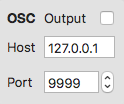Connect-150 OSC Output
Connect can output the sensor data received from the digitizer as OSC (Open Sound Control) messages. The OSC protocol is widely used by a variety of software applications. The OSC host address can be any IP address but note that using an IP address other than localhost (ie. 127.0.0.1) may require NAT traversal, ie. a port may need to be opened on the computer with the specified IP address to allow it to receive the OSC messages. The Port field can be set to any number but note that many port numbers are used by applications. Check whether using the port number could conflict with usage by other applications. The default port number 9999 set by Connect is not guaranteed to be conflict-free.
Output format
OSC output conforms to one of the following formats, depending on the type of sensor and the digitizer's mode of operation:
Analog sensor
/<digitizer_name>/<input_name> <sensor_value>, eg. "/USB-microDig_0208/Input_02/V 76"
Digital sensor, standalone mode
/<digitizer_name>/<input_name><parameter_name> <sensor_value>, eg. "/USB-microDig_0208/Input_02/H 76" for an Orient3D outputting its Heading value.
Digital sensor, host mode
/<digitizer_name>/<input_name>/[<parameter_name_array>] <sensor_value_array>, eg. "/USB-microDig_0208/Input_02/[H,P,R] 298.7, 6, 0" for an Orient3D outputting Heading, Pitch and Roll.
Note that enabling OSC output for a digitizer in host mode is likely more efficient than in standalone mode (with continuous signal processing set for its enabled sensors) since OSC messages contain the values of all active sensors whereas in standalone mode an OSC message is sent separately for each sensor value that is received from the digitizer.
Connect also accepts OSC messages as input. These messages are then sent to the digitizer as MIDI messages for the control of actuators. See the Preferences section for details.
